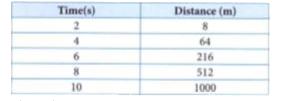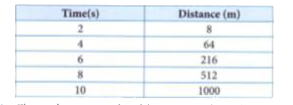According to newtons third law of motion a force acting on a body results in its acceleration .
The correct Answer is:F
According to newtons second law of motion a force acting on a body results in its acceleration .
Topper's Solved these Questions
- BOOK - TARGET PUBLICATIONCHAPTER - GRAVITATIONEXERCISE - ODD ONE OUT3videos
GRAVITATION
- BOOK - TARGET PUBLICATIONCHAPTER - GRAVITATIONEXERCISE - COMPLETE THE ANALOGY4videos
GRAVITATION
- BOOK - TARGET PUBLICATIONCHAPTER - GRAVITATIONEXERCISE - NAME THE FOLLOWING6videos
GRAVITATION
- BOOK - TARGET PUBLICATIONCHAPTER - ENVIRONMENTAL MANAGEMENT EXERCISE - APPLY OUR KNOWLEDGE28videos
ENVIRONMENTAL MANAGEMENT
- BOOK - TARGET PUBLICATIONCHAPTER - HEATEXERCISE - Values to remember10videos
HEAT
Similar Questions
Knowledge Check
- Question 1 - Select One
According to Newton second law of motion
AF=m×vBf=m×aCf=maDf=mv - Question 2 - Select One
According to the third law of motion , action and reaction
Aalways act on same bodyBalways act on different bodies in opposite directionsChave same magnitude and directionsDacts on either body at normal to each other - Question 3 - Select One
In accordance with Newton’s third law of motion -
AAction and reaction never balance each otherBFor appearance of action and reaction, physical contact is not necessaryCThis law is applicable whether the bodies are at rest or they are in motionDAll of these
When a body is moving uniformly along a straight line and there is no force of friction, acceleration/retardation of the body. According to Newton's second law of motion, the magnitude of force acting on a body is the product of mass and acceleration of the body
The distance - time table of an object in motion is given below

The force acting on the objectView SolutionWhen a body is moving uniformly along a straight line and there is no force of friction, acceleration/retardation of the body. According to Newton's second law of motion, the magnitude of force acting on a body is the product of mass and acceleration of the body
The distance - time table of an object in motion is given below

In the given table, acceleration of the object isView SolutionWhen a body is moving uniformly along a straight line and there is no force of friction, acceleration/retardation of the body. According to Newton's second law of motion, the magnitude of force acting on a body is the product of mass and acceleration of the body
The distance - time table of an object in motion is given below

Which among the Newton's laws of motion can be used to calculate the force acting on the object in motion ?View SolutionWhen a body is moving uniformly along a straight line and there is no force of friction, acceleration/retardation of the body. According to Newton's second law of motion, the magnitude of force acting on a body is the product of mass and acceleration of the body
The distance - time table of an object in motion is given below

A passenger in a moving train tosses a coin which falls behind him. This shows that the motion of train isView SolutionWhen a body is moving uniformly along a straight line and there is no force of friction, acceleration/retardation of the body. According to Newton's second law of motion, the magnitude of force acting on a body is the product of mass and acceleration of the body
The distance - time table of an object in motion is given below

Choose the correct order of the corresponding velocities of the object (in ms−1 ) in different time intervals .View Solution

